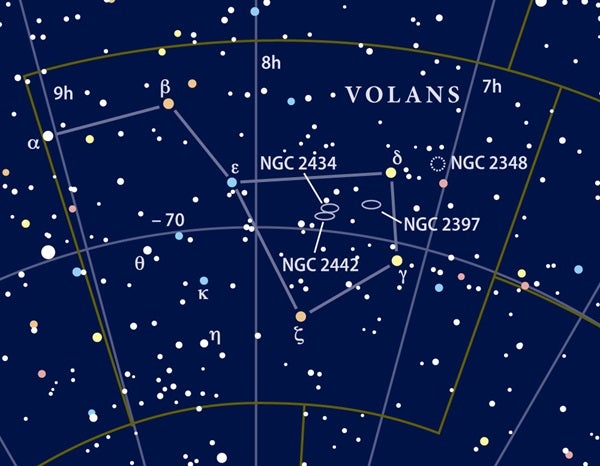Targets for February 18–25, 2016
Small telescope: Double stars k Puppis and 2 Puppis
Large telescope: The Meat Hook Galaxy (NGC 2442)
Large telescope: Procyon B (Alpha [α] Canis Minoris B)
A pair of twins
This week’s small-telescope targets are two double stars in the constellation Puppis the Stern. The first is Markeb (k Puppis). To find it, look 4.1° northeast of magnitude 2.5 Aludra (Eta [η] Canis Majoris).
This nicely spaced binary combines two white stars of nearly identical magnitudes — 4.5 and 4.7. And with a separation of 9.9″, even a 3-inch telescope will split them if you use a magnification above 100x. I’ve often been reminded of car headlights approaching on a dark road as I’ve observed this pair.
Our second double star this week is 2 Puppis. The easiest way to find this stellar pair is to look 0.9° east of open cluster M46. With a separation of 17″, this is a moderately wide pair. The primary shines at magnitude 6.1 and the secondary at magnitude 6.8, which means the brighter star outshines its companion by 90 percent. Like k Puppis, both components appear white.
Awful name, beautiful galaxy
This week’s first large-scope object is the Meat Hook Galaxy (NGC 2442), a barred spiral in the far-southern constellation Volans the Flying Fish.
One look at this treat and you’ll understand how it got its common name. The Meat Hook Galaxy lies 2.3° southeast of magnitude 4.0 Delta (δ) Volantis. It measures 5.4′ by 2.6′. Through a 10-inch telescope, magnitude 10.4 NGC 2442 shows symmetrical “hooks” curving from a 4′-long faint, thick bar. Except for its bright core, the body of the galaxy has a uniform brightness. Its distorted form hints at past interaction with other galaxies. It’s a joy to observe this object through a 16-inch or larger scope.
If you can use such an instrument, look 10′ east-northeast of NGC 2442 for the magnitude 13.4 spiral galaxy PGC 21457. At magnifications above 150x, this galaxy has an unusual rectangular shape.
This one will be tough
This week’s second large-telescope target is Procyon B (Alpha [α] Canis Minoris B) in Canis Minor, the companion to the night sky’s eighth-brightest star.
The name Procyon is Greek for “before the dog.” This refers to the fact that Procyon’s rising occurs slightly before that of Sirius, the Dog Star from the latitude of Europe.
Astronomers measuring Procyon’s motion in the mid-19th century noticed that it didn’t move through space in a straight line. Instead, the star seemed to wobble back and forth as if acted upon by an outside force. It turned out that the force was a companion star.
In 1896, American astronomer James M. Schaeberle discovered Procyon B through the 36-inch refractor at Lick Observatory in California. Like Sirius B, Procyon B is a white dwarf.
Visually, splitting Procyon is tough, but you can try my method. At the 2001 Texas Star Party, I observed it during midevening twilight. I chose this time because Procyon A shines with a magnitude of 0.4 and Procyon B glows faintly at magnitude 10.0. That’s a brightness difference of more than 6,900 times!
The slight brightness from twilight reduced the contrast between the stars and the sky, making the sighting of Procyon B easier.
The seeing was excellent, and I made my sighting through a superb 11-inch Starmaster Dobsonian-mounted Newtonian reflector using an eyepiece that magnified about 300x. You need such a high power because the separation between the two stars is only 4.8″. I confirmed the sighting by asking three observing friends to view the stars and provide a position for the fainter one. Each verified Procyon B in the position I had seen it.
Expand your observing at Astronomy.com
The Sky this Week
Get a daily digest of celestial events coming soon to a sky near you.
Observing Basics
Find more guidance from Senior Editor Michael E. Bakich with his Observing Basics video series.










